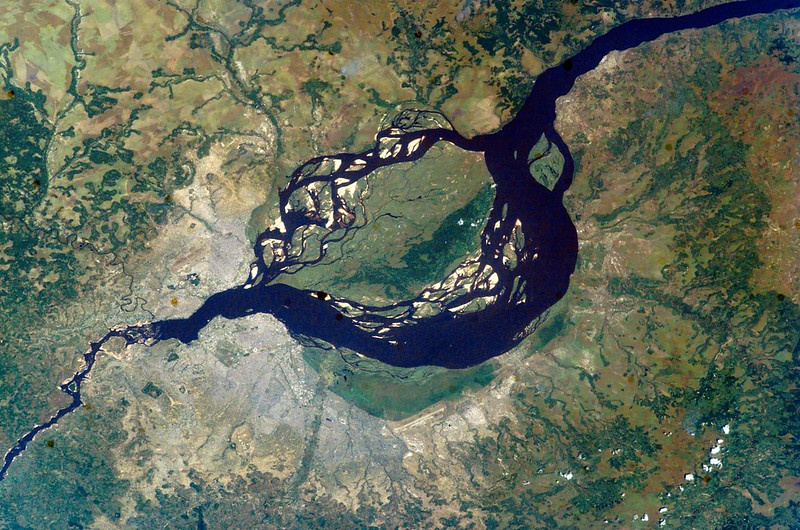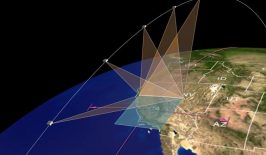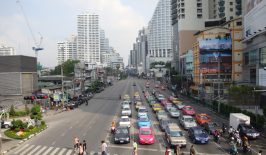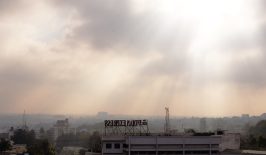Calibrated low-cost sensors in Kinshasa and Brazzaville provide new information on pollution and help scientists model a way to improve access to air quality data.
Particle pollution poses hazards to human health, and among the most dangerous of air pollutants are concentrations of particle pollution smaller than 2.5 micrometers, also known as PM2.5. These fine particles can settle deep in the lungs and enter the bloodstream. Researchers have also connected PM2.5 to respiratory ailments and premature death. Yet many locales lack information about ambient air quality. This dearth of data stems partly from the initial and continued expense of air quality monitoring equipment.
Now researchers have used low-cost sensors to collect years of data on particle pollution at sites in two cities in sub-Saharan Africa: Kinshasa and Brazzaville. In Kinshasa, in the Democratic Republic of Congo, and Brazzaville, in the Republic of Congo, PM2.5 levels are more than 4 times the standard set by the World Health Organization, researchers reported on 25 March in Aerosol and Air Quality Research. The new data highlight a need to improve air quality in these cities.
To date, there’s very little information on air pollution in the large cities of Kinshasa and Brazzaville, said Paulson Kasereka, a natural resources specialist at Ecole Régionale Postuniversitaire d’Aménagement et de Gestion intégrés des Forêts et Territoires tropicaux (ERAIFT), a postgraduate school in Kinshasa that focuses on tropical forest management. “We are not aware of how many lives may be passing away from this,” said Kasereka, one of the study authors. “We are not aware of how many people are suffering from diseases that are caused by air pollution.” With human health on the line, low-cost sensors could be an attainable answer to increased air pollution monitoring, and according to Kasereka, the data from this study could spur government action to curb air pollution and, in conjunction, reduce air pollution–related health risks.
More Accessible Monitoring
In their study, Kasereka and colleagues deployed low-cost PurpleAir PM2.5 monitoring sensors. These monitors collect air quality data in real time and cost about $250 each. Four sensors were used in Kinshasa, where 14.3 million people live, and one monitor was placed in Brazzaville, which has a population of 2.4 million. At one site in Kinshasa, a sensor collected data between March 2018 and July 2020, and at the other sites, data collection occurred between November 2019 and September 2020.
The low-cost sensors used by the team cost about 100 times less than research-grade reference monitors, the authors wrote. However, low-cost sensors are cheaper for a reason, said atmospheric scientist Dan Westervelt of Columbia University’s Lamont-Doherty Earth Observatory in New York, who is also part of the research team. For example, the optics and instrumentation used to measure particles are more rudimentary than research-grade reference monitors, he said.
For more accurate data, the team needed to calibrate their low-cost sensors. To do this, the researchers placed a low-cost sensor beside a more sophisticated, expensive instrument located in Kampala, Uganda—which is located about 2,000 kilometers (about 1,240 miles) from Kinshasa—to watch how data from each device differed. Using 6 months of the side-by-side particle pollution data, combined with humidity and temperature measurements as inputs, the team built a model to correct data collected from the low-cost sensor.
Although Kampala is located far from Kinshasa, these cities have similar temperature and humidity levels, Westervelt said. “We were able to get a really decent model,” Westervelt said. “This is one of the first efforts to calibrate a low-cost sensor in sub-Saharan Africa,” he said.
The calibrated data revealed trends in PM2.5 pollution in Kinshasa and Brazzaville. Particle pollution tended to be highest in the early mornings and around dinnertime, which may relate to activities such as commuting, cooking, and burning trash, which is one of the main means of disposing of waste, Westervelt said. The scientists also observed a roughly 40% drop in PM2.5 due to COVID-19 lockdowns in Kinshasa during April 2020. However, the authors note that future studies should employ more sensors to understand local conditions throughout cities.
Future Efforts to Improve Air Quality Monitoring
Although there are limitations of low-costs sensors, the team’s approach could enable more widespread air quality monitoring. Instead of deploying expensive monitors everywhere, many low-cost sensors could gather data and be calibrated against one monitor in a nearby city or region, said Deo Okure, an air quality scientist at AirQo in Kampala, Uganda, who was not part of the work.
The team plans to add sensors in other cities in the Congo and sub-Saharan Africa. But another next step could be to investigate the sources of air pollution, Okure said. Particle pollution in this region comes mostly from transportation, energy, and industry. For instance, vehicles emit particle pollution and kick up dust on unpaved roads. Particle pollution also comes from the wood or coal burned to heat homes and cook. Data that detangle these contributions could inform efforts to improve air quality.
These sorts of calibrated low-cost sensors could boost air quality monitoring programs in a sustainable way, Okure said. For instance, communities could host the sensors, and schools or clubs could analyze the data. Community involvement, he said, would go a long way toward raising awareness around air quality issues.
Author: Carolyn Wilke
This story originally appeared in AGU’s Eos Magazine and is republished here as part of Covering Climate Now, a global journalism collaboration strengthening coverage of the climate story.







